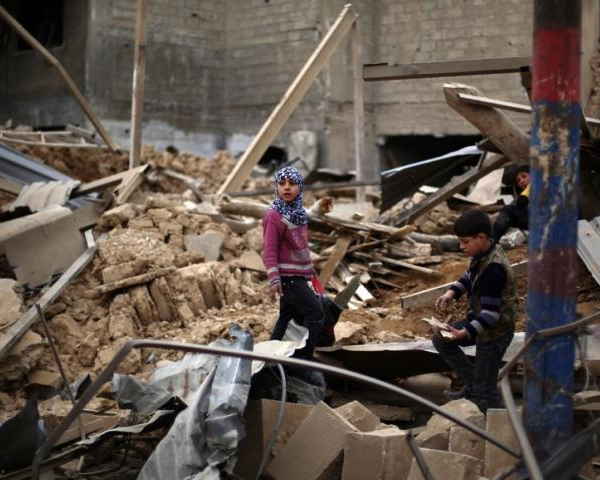 His name was Fadi. He was seventeen-years old, and lived in Aleppo with his family. When the U.S. launched airstrikes against the Islamic State of Iraq and Syria (ISIS), Fadi saw his friend across the street collapse. As Fadi rushed to help his friend, the U.S. dropped another bomb – this time it killed Fadi.
His name was Fadi. He was seventeen-years old, and lived in Aleppo with his family. When the U.S. launched airstrikes against the Islamic State of Iraq and Syria (ISIS), Fadi saw his friend across the street collapse. As Fadi rushed to help his friend, the U.S. dropped another bomb – this time it killed Fadi.
This story, and perhaps many others, comprises a small yet significant portion regarding the consequences of current U.S. policy in combating ISIS – a Sunni Islamist extremist organization aspiring to recreate an empire in the Levant. Since their debut in mid-2014, ISIS has consistently committed various atrocities, and ultimately endangering the Middle East, as well as American interests. Indeed, in a matter of days, ISIS conquered vast areas in Iraq and Syria, while cruelly displacing, enslaving, and murdering, countless of mainstream Sunnis, and other ethno-religious minorities. ISIS territories have since been “utilize[d] for…training, command and control” of ISIS indigenous and foreign fighters. [ref]”Homeland Security Secretary Johnson on ISIS, Ebola, and Preventing Homegrown Terrorism,” Council on Foreign Relations, September 10, 2014, accessed May 13, 2015, http://www.cfr.org/homeland-security/homeland-security-secretary-johnson-isis-ebola-preventing-homegrown-terrorism/p35716[/ref] Indeed, according to Director of National Intelligence James Clapper, ISIS now has “20,000 foreign fighters” from Western Europe, the U.S., and other locations.[ref]”ISIS By the Numbers: Foreign Fighter Total Keeps Growing,” NBC News, February 28, 2015, accessed May 13, 2015, http://www.nbcnews.com/storyline/isis-terror/isis-numbers-foreign-fighter-total-keeps-growing-n314731[/ref] These foreign fighters, in particular, may return to their home states, and launch terrorist attacks. And the organization shows no signs of weakness – ISIS earns “$1 million a day from illicit oil sales, smuggling, and ransom payments,” making it able to afford flying foreign fighters in and out of the region, along with the latest military weapons. [ref]”Homeland Security Secretary Johnson on ISIS, Ebola, and Preventing Homegrown Terrorism,” Council on Foreign Relations, September 10, 2014, accessed May 13, 2015, http://www.cfr.org/homeland-security/homeland-security-secretary-johnson-isis-ebola-preventing-homegrown-terrorism/p35716[/ref] In the midst of this spiraling chaos, the U.S. once again, has stepped into another Middle East debacle, hoping that temporary involvement will quell the violence. And therein lies the Vendetta – will current U.S. military policy work? Or should President Obama, along with the international community, pursue a more in-depth and long-term strategy that targets the fundamental problem surrounding the rise of ISIS?
In protecting the citizens at home, President Obama has increased security at major areas of arrival and departure, in hopes of obstructing potential ISIS fighters from attacking the U.S., or traveling to the Middle East. On the global scale, the U.S. is working multilaterally to provide humanitarian assistance to Iraqi and Syrian refugees scattered throughout the Middle East. Moreover, the international community is disrupting ISIS’ finances through “reducing ISI[S]’s revenue from oil and assets it has plundered; limiting ISI[S]’s ability to extort local populations; stemming ISI[S]’s gains from kidnapping for ransom; and disrupting the flow of external donations to the group.” [ref] “FACT SHEET: Strategy to Counter the Islamic State of Iraq and the Levant (ISIL),” The White House, September 10, 2014, accessed May 13, 2015. https://www.whitehouse.gov/the-press-office/2014/09/10/fact-sheet-strategy-counter-islamic-state-iraq-and-levant-isil[/ref] Finally, President Obama has ordered systematic airstrikes against ISIS held territories, in hopes of protecting “U.S. personnel and facilities in Baghdad and Erbil…, kill[ing] ISIS fighters, destroy[ing] ISIS equipment, [and] protect[ing] Iraqi critical infrastructure…” [ref]Ibid[/ref] In addition, the U.S. has deployed “475 U.S. service members to Iraq to support Iraqi and Kurdish forces with training, intelligence” and equipment.[ref]Ibid[/ref]
Although this policy has rolled-back the organization, both Republicans and Democrats continue to criticize President Obama’s ISIS strategy. As of April 9, 2015, the U.S. has spent approximately $2.11 billion, with a daily average cost of $8.6 million, in Iraq and Syria.[ref]U.S. Department of Defense, “Operation Inherent Resolve,” April 2015, accessed May 13, 2013, http://www.defense.gov/home/features/2014/0814_iraq[/ref] Former President Jimmy Carter, known as a foreign policy dove, believes in placing “somebody on the ground to direct [U.S.] missiles” to the right target.[ref]RT News, “Jimmy Carter slams Obama’s handling of ISIS: ‘We waited too long,’” October 8, 2014, accessed May 13, 2015, http://rt.com/usa/194224-jimmy-carter-obama-isis[/ref] Indeed, inaccurate ground surveillance can only result in unfortunate tragedies, like the death of Fadi. According to investigative reporter Chris Woods, U.S. airstrikes have been responsible for “240 to 300 civilian non-combatant” deaths.[ref]Richard Hall, “Just how many civilians have died in the West’s campaign against ISIS?” The Week, April 23, 2015, accessed May 13, 2015, http://theweek.com/articles/551128/just-how-many-civilians-have-died-wests-campaign-against-isis[/ref] Indeed, even the logistics surrounding U.S. airstrikes have raised questions regarding potential mishaps in protecting civilians. After receiving surveillance reports, indigenous forces telephone U.S. allied security forces with information of current ISIS positions. In a matter of minutes, the west then launches an airstrike. Although air pilots attempt to confirm such reports, the discrepancy between “reported civilian casualties caused by coalition strikes and those confirmed by the coalition is vast.”[ref] Ibid[/ref] Increasing U.S. ground forces, alongside indigenous troops, may prevent these mishaps, and close the discrepancy between reports.
But is America ready for another war? The best opinion is one given by Dr. Eliot A. Cohen from Johns Hopkins University’s School of Advanced International Studies: I do not believe that going light is going to work, but I do not believe that this administration can competently devise, execute, and support a larger campaign. That is the core of the problem in recommending any policy to it at all.[ref] “Ready for War with ISIS?” Foreign Affairs, December 14, 2014, accessed May 13, 2015, https://www.foreignaffairs.com/articles/syria/2014-12-14/ready-war-isis[/ref] The U.S., militarily, can only do so much in the Middle East. But President Obama, along with the international community, can incrementally build a new foundation for a more fluid government system that restores a specific degree of self-autonomy towards various ethno-religious communities. In Iraq, for instance, the U.S. should consider “engineer[ing] a political deal to grant Sunnis autonomy within the Iraqi federal” structure.[ref]Max Boot, “Defeating ISIS,” Council on Foreign Relations, November 14, 2014, accessed May 13, 2015[/ref] Sunni Arabs will then refrain from passively abiding by ISIS rule, which in effectively weakens the terrorist organization. Similarly, the U.S. may want to create a series of “Civil Administrative Councils” (CAC) in various localities and communities all throughout Syria. Indeed, according to Thomas E. Ricks, a former U.S. military journalist, CACs would be “locally elected and networked organizations” that can deliver basic goods and services, “administer justice, and provide security through local police forces to Syrian” communities.[ref]Thomas Ricks, “Fighting ISIS (II): To Work, This Must Be More than Just a Military Operation,” Foreign Policy, October 30, 2014, accessed May 13, 2015. http://foreignpolicy.com/2014/10/30/fighting-isis-ii-to-work-this-must-be-more-than-just-a-military-operation[/ref] In fact, the Syrian Opposition Council can gain legitimacy through CACs, and provide a viable option counter to ISIS. In this manner, Syrian territory is not controlled or politically monopolized by either Shiite or Sunni extremists. Pursuing this durable strategy may offer a more permanent end to ISIS, the restoration of stability in the Middle East, and ultimately the protection of American borders.
Take Action:
Win without War provides a petition for those who wish to see the U.S. and allies stop launching airstrikes in Syria and Iraq, and ultimately an end to an open ended military commitment in the Middle East. On the other hand, Iraq Rescue provides a petition for those who believe the U.S. and allies should intensify military efforts, in line with the rules of war, along with exploring other options for a long term solution.




